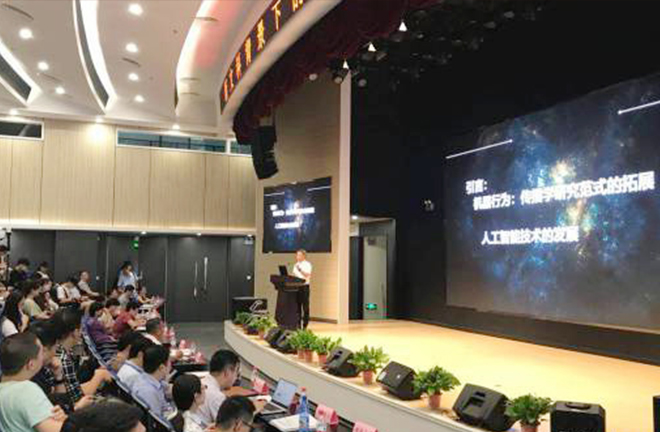Scholars explore computational communication

A seminar on computational communication in Xi’an, Shaanxi Province, on July 17 Photo: Lu Hang/CSST
XI’AN—The 2021 Computational Communication Annual Conference was held in Xi’an, Shaanxi Province, on July 17.
Computational communication is an emerging discipline that collects and analyzes massive amounts of data with the aim of revealing behavioral patterns of individuals and groups.
Scholars at home and abroad exchanged views on the disciplinary development direction of computing communication, changes in a media convergence era, and media reform, in order to examine man-machine behavior in computing communication, online public opinions, and the social logic of computational science. They shed light on the necessity and significance of computational communication research in innovating contemporary social governance to theoretically support disciplinary development, talent training, and the solving of social problems.
Information distribution algorithms
In a big data era, both information consumers and information producers encounter challenges. For users, it is tough to locate information that interests them from among such large amounts of data, while it is also not easy for producers to make their information stand out and attract a wide user base.
With the advancement of information technology and the internet, especially the mobile internet, algorithms have served as a major tool to deal with this dilemma, which through matching users and information, help users find information valuable to them and allows information to be displayed in front of users who are interested in it. This creates a win-win situation for information consumers and information producers. The emergence and widespread application of distribution algorithms means that humans have begun to use machines to solve the problem of information distribution on a large scale, the driving force of which has partly shifted from manpower to automation, or from “people searching for information” to “information looking for people.”
The data-driven dissemination process with the aid of computable methods is called
computational communication. Current intelligent society has overturned concepts of traditional social practice, changing industrial foundations for the construction of communication studies and expanding the intelligent communication model.
According to Zhang Hongzhong, executive dean of the School of Journalism and Communication at Beijing Normal University, traditional media is built upon research on “real people,” while the era of intelligent communication is a collaboration between man and machine, or even machine-dominated communication. The discipline of computational communication contains the study of new phenomena (such as computational communication), new branches (such as automated political communication), and new research objects (such as political rumors). Identities people play in social networks and virtual images with varying degrees of personality traits have become very common. Social robots even “manipulate” public opinions in public health events and major international events. Media and social robots are more likely to impact on negative emotional attributes, while the public tend to exert an influence on positive ones.
Cross-over studies
Traditional social science researchers often neglect the cultivation of computer ability, especially programming ability. Computational communication offers a new research paradigm of communication in the intelligent media era, which is also an inevitable path for communication to carry out disciplinary fusion and integrate arts and sciences in the context of new liberal arts construction. However, computational communication has yet to form a mature research paradigm and theoretical system. Despite existing academic descriptions on phenomena and theoretical research, there is still a dislocation between them.
As an interdisciplinary field, computational communication covers content from sociology, psychology, computer science, physics, and statistics, with its multiple forms being communication networks, text mining, computational advertising, mathematical models, and programming. Jonathan Jianhua Zhu, a professor from the City University of Hong Kong, called for greater academic research in the face of doubts and criticisms targeting big data and algorithms from all walks of life.
Media convergence and social governance
The development of information technology has opened up new space for media convergence, providing support for improving the efficiency of social governance. New media amid the deepening media convergence has increasingly unblocked the public’s participation channels concerning social governance, built diverse social governance platforms, gathered various resources, and enhanced the effectiveness of social governance.
Lai Xiangwu, deputy dean of the School of Journalism and Communication at Northwest University, noted the core of China’s recent media transformation—the construction of convergence media. A dimension measuring convergence media is social capital in its network structure, including macro and micro social capital. A sound convergence media network helps enhance social capital, social coordination, and collective trust, raising the level of social governance.
A unified measurement method has yet to form for understanding the concept of social capital, Lai continued. From a macro perspective, social capital is the structure of social networks. A high-density network reinforces individuals’ observance of group norms, while a low-density network reduces this constraint. From a micro perspective, social capital is social network relationships. The more personal network relationships, the greater the amount of social capital.
The advent of the all-media era has turned traditional one-way information dissemination into two-way and multi-way interaction. Users are not merely information receivers, but also information publishers and disseminators. Zhong Zhijin, deputy dean of the School of Communication and Design at Sun Yat-sen University, noted differentiated and complex emotional expression in online public opinions. Differences are revealed in different types of events and topics, emotional expression on different social platforms, and the emotional expression of different groups. People’s memories of new media events are positively correlated with traditional media reports, and they prefer positive emotional expression that can most stimulate collective memories.
Edited by YANG LANLAN
